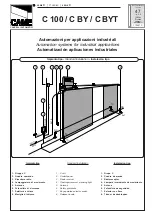
31
1) Disconnect the battery from the control board,
and hook up to a 2-amp battery charger; 2) Ensure
battery and mains power are properly connect-
ed–do not operate the gate for four hours to allow
the battery to charge.
b) Verify the wires connected to VAC, SOLAR (if appli-
cable), OPENER 1, OPENER 2 (if applicable), CYCLE,
SAFETY, EXIT, SHADOW, and RECEIVER terminals
are not loose.
5. If steps 1 – 4 did not solve the problem, please call
customer service.
The gate stops without reaching the fully
opened position.
1. Verify the gate frame is not experiencing an obstruc-
tion, and the gate hinges are not binding.
2. The stall force may be too sensitive. Increase the
force by turning the potentiometer about five
degrees in a clockwise direction. Open the gate
again and determine if the problem still exists.
Continue this process until the trouble is corrected.
CAUTION: Increasing the stall force too much will
decrease the obstruction protection.
3. Reset the gate opener system by placing the ON/OFF
switch in the OFF position for five seconds, then:
a) Return the gate to a fully closed position.
b) Open the gate again to determine if the problem
still exists.
c) If the gate stops again before fully opening pro-
ceed, to
step 4
.
4. Follow the instructions for setting the CLOSED limit.
If the gate continues to stop without reaching the
fully opened position proceed to
step 5
.
5. Open the control box cover, and:
a) Observe if the green STATUS light is blinking once
per second. If blinking faster than once per sec-
ond, the battery is not charged. The battery can be
charged in one of two ways:
1) Disconnect the battery from the control board,
and hook up to a 2-amp battery charger; 2) Ensure
battery and mains power are properly connect-
ed–do not operate the gate for four hours to allow
the battery to charge.
b) Verify if the red or green battery charging indica-
tors are on.
c) Verify the wires connected to VAC, SOLAR (if appli-
cable), OPENER 1, OPENER 2 (if applicable), CYCLE,
SAFETY, EXIT, SHADOW, and RECEIVER terminals
are not loose.
6. If steps 1 – 5 did not solve the problem, please call
customer service.
Preventive Maintenance
• Using a clean, dry cloth, wipe the gate opener shaft,
then apply a silicone spray. The silicone spray will
reduce friction in extreme temperature ranges and
help your gate opener (actuator) operate smoothly.
Do this every 4–6 weeks.
• Regularly check gate hinges to make sure gate is
swinging smoothly and freely. Grease hinges if
needed.
• Check your installation periodically, as hardware and
posts will shift. Brackets may need to be adjusted or
hardware may need to be tightened.
• Maintain the area around your gate. Keep the area
free of objects that can prevent the gate from swing-
ing freely.
Troubleshooting
The gate stops without reaching the fully closed
position.
1. Verify the gate frame is not experiencing an obstruc-
tion, and the gate hinges are not binding.
2. The stall force may be too sensitive. Increase the
force by turning the potentiometer about five
degrees in a clockwise direction. Close the gate again
and determine if the problem still exists. Continue
this process until the trouble is corrected. CAUTION:
Increasing the stall force too much will decrease the
obstruction protection.
3. Reset the gate opener system by placing the ON/OFF
switch in the OFF position for five seconds then:
a) Open the gate to a fully opened position.
b) Close the gate again to determine if the problem
still exists.
c) If the gate stops before fully closing, return the
gate to fully opened position and follow the steps
outlined earlier in the manual, “setting the closed
limit.” If this procedure does not correct the cur-
rent problem proceed to
step 4
.
4. Open the control box cover, and:
a) Observe if the green STATUS light is blinking once
per second. If blinking faster than once per sec-
ond, the battery is not charged. The battery can be
charged in one of two ways:
MAINTENANCE AND
TROUBLESHOOTING
GUIDE





































